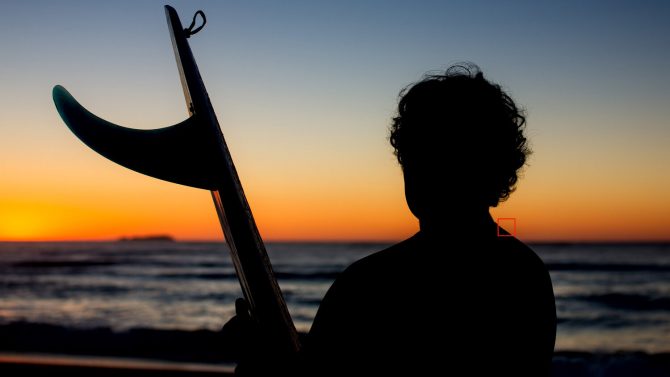Editor’s Note: We’re excited to partner with longtime contributor and esteemed photographer Tom Woods of ST Images on the release of his new water photography course. If you’re interested in improving your surf and water photography chops, check it out here.
I get asked about precise focusing often, and there are many factors in answering those questions that can give a much better strike rate with perfectly clear pictures. But here, I “focus” on one point that will increase your success rate with tack-sharp images.
First up I mostly use and recommend single point focusing for still photography. This means selecting one single point of focus in the viewfinder and moving that to the place where you want the image focused with a decent composition. The all-over focusing points tend to just lock in the closest thing and that may not be what you want to focus on. For instance, the tip of the nose in a portrait may be chosen as the autofocus focal point. You would rather have the eye in sharp focus, however. The best way of doing this is to select a single point of focus and compose that single focusing point over the eye.
If the subject is really unpredictable and you are further away then consider switching to zone autofocus. This one will use a bunch of focusing points around each other and increase your chances of nailing that perfect picture.
But beyond those simple steps, I want to cover situations where you can help the effectiveness of the autofocus in your camera to get a better result:
First up, you have to understand a little bit about how the camera and lens get focus in the first place. Most cameras these days use a combination of phase detection and contrast detection, and some use one of these two.
Phase detection is a smarter form of autofocus and it has an incredible computer built inside your camera to determine a well-focused distance to your subject. Without getting into the tech aspects of how that all works, just know and trust it does a great job most of the time.
The contrast-detection, however, needs some sort of contrast to be effective. Together, these do a great job and I feel the phase-detection uses contrast to get that focus happening quicker. A good way to understand this even better is to point your camera into a blue sky with no clouds in the foreground and see how well the camera focuses. You will probably find it doesn’t really go so well, and that’s because it has zero contrast in the scene to lock on to.

photo: STImages
In difficult lighting situations, you can employ a few techniques to help your autofocus lock in faster and more precise.
Take the silhouette picture, for example. If I put my single point focus in the middle of this surfer’s body, the camera may hunt around to find focus, continually going in and out of focus until the subject gets uneasy or you miss the moment.
If you instead place that single focus point on the edge of the subject’s shoulder or somewhere on the edge of his face then the camera has some contrast with the brighter sky to lock in the precise distance to the subject that will result in a well-focused image. The camera can get focus much quicker and more accurately this way and you will nail the moment without having your autofocus system hold you up. I use this for nearly all of my day-to-day photography. In particular, I use it when shooting into the sun through my water housing. You need ultra-quick focusing in surf action situations and just using this tiny little trick has led to better quality shots than if I hadn’t considered finding the contrast.
I started using this contrast method to get focus many years ago and now it’s just a reflex. It was a crucial method 10 to 20 years ago when autofocus systems weren’t as strong, but before this video, I did some extensive testing with my three different Canon cameras and examined firsthand how it does make a difference in focusing speed.
If you don’t already do this or consider it when taking photos, I suggest giving it a go. See if it helps with your speed of focusing. There’s no doubt it has with my photography.
It’s just a tiny tip today, but those little things that you introduce into your workflow will make a difference in your ability to get great results consistently.

